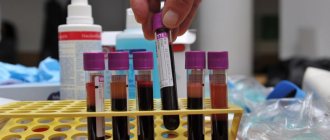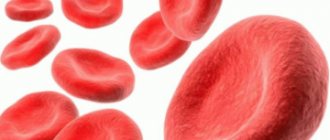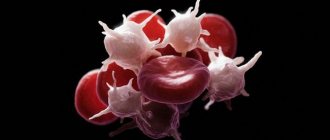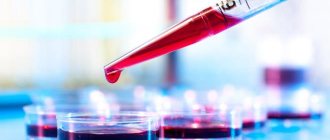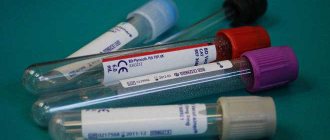Formed elements of blood
The components of blood are red blood cells, leukocytes, platelets, and plasma. The main hematopoietic organ is the red bone marrow. Stem cells (blasts) are formed in it. All formed elements are formed from blasts. Therefore, disruption of the red bone marrow leads to the appearance of blood diseases. White blood cells are primarily produced in the lymph nodes and spleen.
Red blood cells deliver oxygen to tissues and remove carbon dioxide. Leukocytes protect humans from infectious, bacterial, and parasitic diseases and participate in cell regeneration. Platelets participate in blood clotting processes and clog damaged areas of tissue and blood vessels.
Blood diseases
Blood diseases are numerous and varied in their origin. They are associated with pathology of the structure of blood cells or a violation of the functions they perform. Also, some diseases affect plasma, the liquid component in which cells are located. Blood diseases, a list, and the causes of their occurrence are carefully studied by doctors and scientists, some have not yet been determined.
Blood cells - red blood cells, white blood cells and platelets. Erythrocytes - red blood cells - carry oxygen to the tissues of internal organs. Leukocytes - white blood cells - fight infections and foreign bodies that enter the body. Platelets are colorless cells responsible for clotting. Plasma is a viscous protein liquid that contains blood cells. Due to the serious functionality of the circulatory system, blood diseases are mostly dangerous and even difficult to cure.
Diseases of the blood and blood system
Blood diseases are associated with changes in the structure, functions, number of leukocytes, platelets, erythrocytes, and plasma. The term “blood system disease” is more correct. Since pathologies are associated not only with formed elements, but also with changes in the functioning of the hematopoietic organs. A hematologist can tell you what types of blood diseases there are.
Hematopoietic organs include bone marrow, lymphoid tissue, thymus, and spleen. They make up the blood system and are responsible for changes in the formed elements. Infections, tumors, radiation, genetic and toxic pathologies lead to changes in the functioning of the hematopoietic organs.
The list of blood diseases includes more than 90 pathologies. Depending on the causative factor, three broad groups are distinguished. The first is hereditary diseases, such as sickle cell anemia, erythremia, hemophilia. The second is infectious diseases, such as infectious mononucleosis and malaria. The third group includes acquired pathologies - disseminated intravascular coagulation syndrome, hemorrhagic anemia, autoimmune processes.
Diseases of the hemoblastosis group
These are mainly oncological diseases of the blood; the list of the most common includes types of leukemia. The latter, in turn, are divided into two types - acute (a large number of cancer cells, do not perform functions) and chronic (proceeds slowly, the functions of blood cells are performed).
Acute myeloblastic leukemia is a disorder in the division of bone marrow cells and their maturation. Depending on the nature of the disease, the following types of acute leukemia are distinguished:
- without ripening;
- with maturation;
- promyelocytic;
- myelomonoblastic;
- monoblastic;
- erythroblastic;
- megakaryoblastic;
- lymphoblastic T-cell;
- lymphoblastic B-cell;
- panmyeloid leukemia.
Chronic forms of leukemia:
- myeloid leukemia;
- erythromyelosis;
- monocytic leukemia;
- megakaryocytic leukemia.
The above chronic diseases are taken into account.
Letterer-Siwe disease is the proliferation of immune system cells in various organs; the origin of the disease is unknown.
Myelodysplastic syndrome is a group of diseases affecting the bone marrow, which include, for example, subleukemic myelosis.
Blood diseases associated with abnormalities in leukocytes
Pathologies of white blood cells have a predominantly malignant course. Main groups of diseases:
- Lymphogranulomatosis (Hodgkin's disease) is a tumor process in the lymphatic system that affects lymphoid tissue. It manifests itself as enlarged and painful lymph nodes, loss of weight, loss of appetite, itching and high fever. As it progresses, hemorrhagic and anemic syndrome appears.
- Leukopenia is a decrease in the level of blood leukocytes. It is a secondary sign of the underlying disease. Leukopenia can be caused by infectious diseases, E. coli, and medications. It manifests itself as inflammation in the oral cavity, fever, and swelling of the tonsils.
- Leukemia is a malignant oncological disease. The etiology is not fully understood. Leukemia is classified as a systemic blood disease. It is more often detected in people who have undergone chemotherapy, exposure to toxic chemicals and have genetic disorders. The disease is manifested by a decrease in the amount of hemoglobin, platelets, and leukocytes. This leads to bleeding, suppression of the immune system, and anemia.
- Leukocytosis – develops against the background of cancer and infectious diseases. It manifests itself as pain in the arms and legs, sweating, dizziness, and headache.
- Non-Hodgkin's lymphomas are cancers that differ from Hodgkin's lymphoma in cell structure. The causes of lymphomas are not fully understood by science, but their development is associated with mutation of lymphocytes. Mutation can be caused by congenital diseases of the immune system, HIV infection, radiation exposure, organ transplantation.
- Myeloma (plasmocytoma) is a paraproteinemic leukemia. Associated with the rapid formation of abnormal cells in the bone marrow. Their reproduction leads to the displacement of healthy leukocytes and red blood cells from bone tissue. The formation of abnormal bodies is facilitated by radiation, genetic disorders, prolonged stimulation with antigens, and infections. Plasmacytoma manifests itself as malfunctions of the nervous system, destruction of bone tissue, and damage to internal organs.
Important! Leukocytosis can be physiological. The level of leukocytes can increase during heavy physical exertion, emotional stress, and sudden changes in temperature.
List of diseases affecting the blood
If you list all the blood diseases, the list will be huge. They differ in the reasons for their appearance in the body, the specifics of cell damage, symptoms and many other factors. Anemia is the most common pathology affecting red blood cells. Signs of anemia are a decrease in the number of red blood cells and hemoglobin. The reason for this may be reduced production or large blood loss. Hemoblastoses - most of this group of diseases is occupied by leukemia, or leukemia - blood cancer. As the disease progresses, blood cells transform into malignant tumors. The cause of the disease has not yet been clarified. Lymphoma is also an oncological disease; pathological processes occur in the lymphatic system, and leukocytes become malignant.
Myeloma is a blood cancer that affects the plasma. Hemorrhagic syndromes of this disease are associated with a clotting problem. They are mostly congenital, such as hemophilia. It manifests itself as hemorrhages in joints, muscles and internal organs. Agammaglobulinemia is a hereditary deficiency of serum plasma proteins. There are so-called systemic blood diseases, the list of which includes pathologies affecting individual systems of the body (immune, lymphatic) or the entire body as a whole.
Platelet diseases
Platelet pathologies are associated with an increase or decrease in their number in the blood. And also with a violation of functional properties - aggregation, adhesion. Since platelets are responsible for blood clotting, disruption of their function leads to bleeding and the appearance of blood clots. Platelet diseases include:
- thrombocytopenia – decreased platelet levels. Includes idiopathic, thrombotic purpura. The diseases are associated with damage to the spleen and bone marrow. Manifested by spontaneous bleeding from the nose, gums, and internal organs. The blood loses its clotting ability;
- thrombocytosis - an increase in the number of platelets. There can be primary (tumor) and secondary (reactive). The first are associated with a defect in stem cells in the bone marrow. The second are changes of a benign nature, with impaired platelet function. Pathologies are manifested by microcirculation disorders due to the formation of blood clots;
- disseminated intravascular coagulation (DIC syndrome) is associated with impaired blood coagulation in blood vessels, activation of the fibrinolytic system, the appearance of blood clots, and bleeding. DIC syndrome is a complication of diseases. These include infectious and inflammatory processes, shock, transfusion of incompatible blood, massive bleeding.
Also, platelet pathologies include coagulopathies associated with a deficiency of coagulation factors - deficiency of coagulation factor I, II, V, VII, VIII, IX, X, XI, XII, XIII.
Principles of classification
All blood diseases in outpatient practice are conventionally divided into several broad groups (based on the blood elements that have undergone changes):
- Anemia.
- Hemorrhagic diathesis or pathologies of the homeostasis system.
- Hemoblastosis: tumors of blood cells, bone marrow and lymph nodes.
- Other ailments.
Diseases of the blood system that are included in these groups are divided into subgroups. Types of anemia (by reasons of occurrence):
- associated with impaired hemoglobin secretion or red blood cell production (aplastic, congenital);
- caused by the accelerated breakdown of hemoglobin and red blood cells (defective structure of hemoglobin);
- provoked by blood loss (posthemorrhagic anemia).
The most common anemia is deficiency anemia, which is caused by a lack of substances essential for the secretion of hemoglobin and red blood cells by the hematopoietic organs. Severe chronic diseases of the circulatory system occupy the 2nd position in prevalence.
What are hemoblastoses?
Hemoblastoses are cancerous blood tumors that originate in the hematopoietic organs and lymph nodes. They are divided into 2 broad groups:
- Leukemia.
- Lymphomas.
Leukemia causes primary damage to the hematopoietic organs (bone marrow) and the appearance of a significant number of pathogenic cells (blasts) in the blood. Lymphomas lead to lesions of lymphoid tissues, disruption of the structure and activity of lymphocytes. In this case, the appearance of malignant nodes and damage to the bone marrow occurs. Leukemias are divided into acute (lymphoblastic T- or B-cell) and chronic (lymphoproliferative, monocytoproliferative).
All types of acute and chronic leukemia occur due to pathological cell development. This occurs in the bone marrow at different stages. The acute form of leukemia is malignant, so it is less responsive to therapy and often has a poor prognosis.
Lymphomas can be Hodgkin's (lymphogranulomatosis) and non-Hodgkin's. The former can occur in different ways, having their own manifestations and indications for treatment. Types of non-Hodgkin's lymphomas:
- follicular;
- diffuse;
- peripheral.
Hemorrhagic diathesis leads to blood clotting disorders. These blood diseases, the list of which is very long, often provoke bleeding. Such pathologies include:
- thrombocytopenia;
- thrombocytopathy;
- failures of the kinin-kallikrein system (Fletcher and Williams defects);
- acquired and hereditary coagulopathies.
Plasma diseases
One of the most common plasma diseases is sepsis. This is a generalized blood infection. It occurs as a complication in purulent wounds, burns, and radiation therapy. Chronic diseases and infections (oncology, HIV infection) can also lead to its development. Sepsis is manifested by high fever, chills, a drop in blood pressure, increased heart rate, and hemorrhages in the mucous membranes and sclera of the eyes. The skin becomes marbled and a rash appears.
Hemophilia is a deficiency or absence of protein in the plasma, leading to a blood clotting disorder. It is hereditary. It manifests itself as hemorrhages in the joint cavity, parenchymal bleeding. Children with hemophilia have pale skin with a thin layer of fat, and even minor cuts lead to severe bleeding.
Important! Hemophilia is detected only in men; women do not suffer from this disease, but they can be carriers of the hemophilia gene.
Causes of the disease
The main causes of the occurrence and development of blood diseases include the presence of outdated, previously suffered injuries, the consequences of surgical intervention, and all kinds of allergic manifestations. In some cases, the causes of the development of hematological diseases are the consequences of treatment for tuberculosis, HIV, and other serious diseases.
The likelihood of a particular blood disease can be traced through the study of heredity data. The main attention here is paid to previously recorded cases of blood transfusions, facts of drug use by relatives, sexual orientation of family members, as well as lifestyle in general. Diseases can be transmitted through blood due to disordered sexual life.
Human blood diseases can occur under the influence of various etiological factors.
Thus, anemia can develop as a result of chronic or acute blood loss, increased breakdown of red blood cells, and impaired hematopoiesis (blood formation).
The causes of leukemia often lie in a violation of the chromosomal composition. Leukemia can also develop as a result of prolonged exposure to unfavorable environmental factors on the body, such as ionizing radiation, chemical mutagens (cytostatics, some immunosuppressants, etc.), chemotherapy.
Risk factors that can lead to the development of lymphogranulomatosis are Epstein-Barr virus and HIV infection.
Blood diseases have been studied for a long time, and there are studies that have shown that there is a genetic predisposition to these problems.
If there have been cases of blood disease in the family, then it is necessary to keep the situation under control: get tested more often, undergo medical examinations, and consult a hematologist.
Now let's look at the causes of some blood diseases.
- Anemia is a lack of iron, vitamin B12, folic acid in the body, and a decrease in hemoglobin levels. Anemia occurs for various reasons. This:
- Drop in hemoglobin level.
- The destruction of red blood cells in a very short period of time is a condition called hemolytic anemia.
- Regular short-term bleeding or severe one-time blood loss - posthemorrhagic anemia.
2. Leukemia. This serious disease has not been fully studied. But it is known that hereditary predisposition, ionizing radiation, chemicals, and viruses play a major role.
Most often, the disease is caused by a number of reasons that only aggravate the situation.
Now it’s clear what the symptoms of blood cancer are. Blood cancer can have a variety of causes; they are not fully understood. Only one thing is clear: this is one of the most dangerous diseases. But some risk factors can be identified:
- Genetic predisposition to cell mutations.
- Effect of radioactive radiation.
- Work in hazardous production.
- Chemotherapy and certain drugs.
- Exposure to viruses that affect healthy cells. The human immunodeficiency virus is especially noteworthy.
- Smoking and drinking alcohol.
Hemorrhagic diathesis
A group of pathologies that are associated with high bleeding of tissues and organs. The causes of blood diseases are the insufficiency of elements in hemostasis. The group includes acquired and genetically determined diseases. Hereditary ones develop due to congenital changes in the walls of blood vessels, the presence of abnormal platelets, megakaryocytes, and plasma proteins.
The second group is associated with vascular damage due to acquired diseases. Symptoms of hemorrhagic diathesis are: small dark red rashes on the skin, hematomas of different sizes that appear in different parts of the body. Often diathesis leads to hemorrhages in the joint cavity. Microangiomatomas appear - these are dark cherry spots that appear in a certain area and do not spread throughout the body.
Symptoms
The clinical picture of diseases of formed elements and plasma is not specific. Patients attribute many common symptoms to manifestations of a cold, overwork, and lack of vitamins. Symptoms of blood diseases in adults are:
- bleeding from the gums, uterus, nose, internal organs;
- muscle weakness, in the absence of physical activity;
- enlarged lymph nodes (in the neck, groin, armpits);
- hematomas on the skin (appearing in the absence of injuries or blows);
- increased body temperature, in the absence of bacterial or infectious diseases;
- change in skin color (pallor, jaundice, cyanosis);
- fatigue, apathy, drowsiness;
- skin rash;
- hair fragility;
- changing the shape of nails;
- dry skin and mucous membranes.
If close relatives of the patient have blood diseases, then this is a risk factor.
Diseases with enlarged lymph nodes
The syndrome is called lymphadenopathic. Accompanied by the proliferation of lymph node tissue, compression of neighboring vessels and organs. Depending on the location of the enlarged nodes, symptoms appear:
- shortness of breath and dry cough (mediastinal lymph nodes);
- “overflowing” of the intestines, bloating, stool disorders (retroperitoneal and mesenteric nodes).
This is what enlarged lymph nodes in the neck look like
Syndromes in diseases of the blood system
Symptoms of blood diseases are varied, so they are grouped into clinical syndromes. Types of syndromes:
- Intoxicating. Includes weakness, palpitations, shortness of breath on exertion, sudden weight loss, persistent fever with excessive sweating. Intoxication syndrome is manifested by painful itching of the skin.
- Plethoric. It manifests itself as tinnitus, burning in the fingers, itchy skin, goosebumps, pain in the feet, heart, rush of blood to the brain.
- Anemic. Includes: increased fatigue, fainting, irritability, headaches, dizziness, flashing “spots” before the eyes. As well as hair loss, brittle nails, dry and pale skin.
- Ulcerative-necrotic. It is characterized by stool disturbances, damage to the mucous membranes, pain in the abdomen and throat, and drooling.
- Icteric. Associated with increased bilirubin levels against the background of hemolytic anemia. Manifests itself as a yellowish color of the skin.
- Osteoarthropathic. It manifests itself as pain and swelling in the joints, bones, and redness of the skin over them.
- Lymphadenopathy. Syndrome with enlarged lymph nodes in the inguinal, axillary, and neck areas.
- Hemorrhagic. Associated with the appearance of hemorrhages in the skin, joints, and muscles. Intestinal, nasal, uterine bleeding, and petechial rash appear.
- Immunodeficient. Frequent infectious diseases with complications.
- Protein pathology syndrome. The level of paraproteins in the blood increases. This is manifested by hypertension, drowsiness, retinopathy, bleeding of mucous membranes, impaired functioning of the kidneys and heart.
- Sideropenic. Associated with iron deficiency. A person's taste and smell are distorted (they want to eat chalk, lime, they like the smell of acetone, gasoline, varnish). Weakness appears in the muscles, tightness in the corners of the mouth, dry, pale skin. Nails become thin, brittle and take on a concave shape.
- Feverish. Persistent increase in body temperature.
- Hepato-splenomegaly. The syndrome is characterized by an enlargement of the boundaries of the spleen and liver. This is manifested by pain and heaviness in the upper abdominal cavity.
Important! With any blood disease, several syndromes appear at once.
Anemia
Anemia can be an independent pathology or occur as a syndrome of some other diseases.
Anemia is a group of syndromes, the common feature of which is a decrease in the level of hemoglobin in the blood. Sometimes anemia is an independent disease (hypo- or aplastic anemia, etc.), but more often it occurs as a syndrome in other diseases of the blood system or other body systems.
There are several types of anemia, the common clinical sign of which is anemic syndrome associated with oxygen starvation of tissues: hypoxia.
The main manifestations of anemic syndrome are as follows:
- pallor of the skin and visible mucous membranes (oral cavity), nail bed;
- increased fatigue, a feeling of general weakness and weakness;
- dizziness, flashing spots before the eyes, headaches, tinnitus;
- sleep disturbances, deterioration or complete absence of appetite, sexual desire;
- increased breathing, feeling of lack of air: shortness of breath;
- palpitations, increased heart rate: tachycardia.
Manifestations of iron deficiency anemia are caused not only by hypoxia of organs and tissues, but also by iron deficiency in the body, the symptoms of which are called sideropenic syndrome:
- dry skin;
- cracks, ulcerations in the corners of the mouth - angular stomatitis;
- layering, brittleness, cross-striations of nails; they are flat, sometimes even concave;
- burning sensation of the tongue;
- perversion of taste, desire to eat toothpaste, chalk, ashes;
- addiction to some atypical odors: gasoline, acetone and others;
- difficulty swallowing solid and dry foods;
- in females - urinary disorders, urinary incontinence when laughing, coughing; in children - bedwetting;
- muscle weakness;
- in severe cases - a feeling of heaviness, pain in the stomach.
B12 and folate deficiency anemia are characterized by the following manifestations:
- hypoxic or anemic syndrome (signs described above);
- signs of damage to the gastrointestinal tract (aversion to meat food, loss of appetite, pain and tingling in the tip of the tongue, impaired taste, “varnished” tongue, nausea, vomiting, heartburn, belching, bowel disorders - constipation, diarrhea);
- signs of spinal cord damage, or funicular myelosis (headache, numbness in the limbs, tingling and crawling sensations, unsteady gait);
- psycho-neurological disorders (irritability, inability to perform simple mathematical functions).
Hypo- and aplastic anemia usually begin gradually, but sometimes they debut acutely and progress rapidly. The manifestations of these diseases can be grouped into three syndromes:
- anemic (discussed above);
- hemorrhagic (various sizes - dotted or in the form of spots - hemorrhages on the skin, nasal, uterine, gastrointestinal bleeding);
- immunodeficiency, or infectious-toxic (persistent increase in body temperature, infectious diseases of any organs - otitis, tonsillitis, bronchitis, pneumonia, pyelonephritis, cystitis, and so on).
Hemolytic anemia is externally manifested by signs of hemolysis (destruction of red blood cells):
- yellow coloration of the skin and sclera;
- an increase in the size of the spleen (the patient notices a formation in the left side);
- increased body temperature;
- red, black, or brown urine;
- anemic syndrome;
- sideropenic syndrome.
Diagnostics, tests for blood diseases
A hematologist treats diseases of the blood system, but, as a rule, patients first turn to a general practitioner. The examination begins with the collection of complaints and examination. Subjective symptoms (patient complaints) may be uninformative and are signs of diseases not related to the pathology of the blood system. Objective signs are:
- hematomas on the skin;
- enlarged lymph nodes;
- pale (icteric) skin;
- rash;
- increased volume of the spleen and liver.
If symptoms indicating pathology in the circulatory system are identified, laboratory diagnostics are performed. Hematological tests:
- coagulogram – reveals disturbances in the coagulation system;
- general analysis - shows the level of formed elements, hemoglobin;
- bone marrow examination - provides information about the state of hematopoietic germs;
- lymphatic cell histology – displays the presence of abnormal cells in the lymph nodes;
- biochemical analysis - allows you to determine the level of enzymes;
- immunocytochemistry, cytometry, cytochemistry – clarification of the type of hemoblastosis.
If bones, joints, or internal organs are affected, additional diagnostic methods are used:
- X-ray of bones, chest;
- computed tomography;
- Ultrasound of internal organs;
- magnetic resonance imaging.
For malignant blood diseases, a diagnosis can only be made using a combination of laboratory and instrumental research methods.
Symptoms of blood cancer
Diseases of the blood and blood-forming organs have very different symptoms. This depends on the involvement of cells in pathological changes. Anemia manifests itself as symptoms of oxygen deficiency in the body, and hemorrhagic vasculitis causes bleeding. In this regard, there is no general clinical picture for all blood diseases.
Conventionally, manifestations of diseases of the blood and hematopoietic organs are distinguished, which to one degree or another are inherent in all of them. Most of these diseases cause general weakness, increased fatigue, dizziness, shortness of breath, tachycardia, and problems with appetite. There is a stable increase in body temperature, prolonged inflammation, itching, disruptions in the sense of taste and smell, bone pain, subcutaneous hemorrhages, bleeding of the mucous membranes of various organs, pain in the liver, and decreased performance. If the mentioned signs of a blood disease appear, a person should consult a specialist as soon as possible.
A stable set of symptoms is associated with the occurrence of various syndromes (anemic, hemorrhagic). Such symptoms in adults and children occur with various blood diseases. Anemic blood diseases have the following symptoms:
- paleness of the skin and mucous membranes;
- drying or waterlogging of the skin;
- bleeding;
- dizziness;
- problems with gait;
- prostration;
- tachycardia.
The problem lies in the fact that blood diseases often present with symptoms similar to many other diseases. Here are some possible signs that indicate a blood problem:
- Weakness.
- Feeling unwell for no apparent reason.
- Frequent headaches.
- Dizziness.
- Fatigue quickly.
- Pain in the heart area, tachycardia.
- Pallor.
- Noise in ears.
- Visual impairment.
- Possible skin itching.
- Exacerbation of chronic diseases.
All these symptoms are characteristic of many diseases, but if they are present, it means that the immune system is weakened, and this is a reason to consult a doctor. A blood disease is very dangerous; symptoms in adult patients, noticed by the patient or doctor, cannot be ignored.
What is blood cancer, how to identify and treat? Symptoms in adults do not attract much attention at first. Often, loved ones notice a deterioration in health. The patient has:
- Weakness.
- Frequent dizziness.
- Rising temperature for no reason.
- Pale, dry, possibly yellowish skin.
- Weight loss and loss of appetite.
- Bone pain.
- Enlarged lymph nodes.
- Skin rashes are possible.
- Excessive sleepiness and irritability.
These are symptoms characteristic of a disease such as blood cancer. A blood test in adult patients should be the first in research and diagnosis methods, but not the main one. A thorough examination should confirm the presence of the disease.
What is blood cancer? This is a tumor that develops from a single bone marrow cell through uncontrolled division, while it displaces healthy cells. Moreover, only leukocytes are degenerated, hence another name for blood cancer - leukemia. There are several types of this dangerous disease:
- Leukemia is a tumor of brain cells.
- Acute leukemia is aggressive, affecting young, immature blood cells.
- Chronic leukemia is made from mature cells and progresses more easily.
- Hematosarcoma is extremely malignant and is formed from lymphatic tissue.
An accurate diagnosis can only be made after a thorough examination.
Treatment
The goal of treating diseases of the hematopoietic organs and blood is to reduce the manifestations of symptoms and restore them. Treatment is prescribed individually, depending on the type of disease, its severity and the presence of complications.
Drug therapy
There are no universal treatments that help with all types of blood diseases. The main groups of drugs used are:
- Antianemic drugs. A group of drugs used to treat anemia. They replenish iron deficiency, increase hemoglobin levels, and protect red blood cells from damage.
- Hemostatic drugs. Used to stop and prevent bleeding. This group includes fibrinolysin inhibitors, coagulants, and platelet aggregation stimulators.
- Plasma replacement solutions. Necessary for restoring the volume of circulating fluid, introducing nutritional components, and correcting the chemical composition of the blood. And also for the administration of platelets, erythrocytes, leukocytes when their levels decrease.
- Anticoagulants. Preparations for dissolving formed blood clots and preventing their development. Reduce blood viscosity.
- Glucocorticosteroids. Hormonal drugs with anti-inflammatory, immunomodulatory, antiallergic effects.
Severe forms of the disease require hospitalization and inpatient treatment; in mild cases, therapy can be carried out on an outpatient basis.
Non-drug treatment
In the presence of tumor diseases of the blood, bone marrow transplantation and chemotherapy are performed. After a bone marrow transplant, a person may have a chance to get rid of cancer cells.
Chemotherapy
Treatment with chemotherapy is an effective way to destroy abnormal cells. Therapy is carried out using highly toxic drugs that have a detrimental effect not only on cancer cells, but also on healthy cells. In this regard, patients experience hair loss, reproductive function is impaired, and gastrointestinal disorders appear.
After chemotherapy, anemia develops, so doctors carry out therapy to restore blood cells. Doctors can prescribe radiation therapy to the patient, which is also aimed at destroying cancer cells. The treatment involves the introduction of radioactive phosphorus into the patient's body. Cancer cells can adapt to chemotherapy, in which case the treatment is repeated.
Bone marrow transplantation
The operation is prescribed for young people and children; the transplant is not performed in the elderly. Before treatment, patients must undergo chemotherapy. After the cancer cells are destroyed, bone marrow is transplanted from a healthy donor. The best donors are close relatives, as they have a similar genetic structure to the patient.
The donor's cells are introduced into the sick person's body intravenously through a catheter. After transplantation, doctors prescribe a course of drug therapy. Its goal is to prevent infections, prevent bleeding, and anemia. To prevent rejection of the transplanted cells, immunosuppressants are prescribed. They inhibit the functioning of the hematopoietic system and weaken the immune system. A bone marrow transplant is a dangerous procedure and may cause complications, but it is an opportunity to cure cancer forever.
Risk factors
Certain factors may increase a person's risk of blood disorders, which are listed below:
- Anemia. Distributed by almost 2 billion people worldwide. Anemia occurs in old age due to iron deficiency. It is also common in women due to blood loss during menstrual bleeding.
- Leukopenia is a consequence of an infection that affects the bone marrow. Occurs due to chemotherapy, radiation therapy and drugs such as clozapine, chloramphenicol, etc.
- Thrombocytopenia - observed mainly in people who are dependent on alcohol. Some medications, such as hydroxyurea, interferons, alpha and beta heparin, can cause a decrease in platelet counts. Appears in people with vitamin B12 and folic acid deficiency.
Prevention
In the prevention of congenital blood diseases, it is important to undergo medical genetic counseling and donate blood to identify genetic pathologies. These preventive measures are especially important for women planning pregnancy. Geneticists study the pedigree and can determine the risk of developing diseases in the unborn child.
To prevent acquired diseases, you need to undergo annual preventive examinations. It is necessary to promptly treat identified diseases in order to prevent them from becoming severe and developing complications. To prevent the development of deficiency anemia, you need to eat a balanced diet, eat foods high in vitamins and microelements.
Important! Vegetarians are more likely to develop anemia, so they should definitely eat foods rich in iron.
Complications
Diseases of the blood system can affect a person’s ability to work. Severe forms of diseases, especially malignant ones, can lead to disability. Complications of diseases:
- development of anemia due to increased bleeding of tissues and organs;
- blood poisoning due to decreased immunity, damage to leukocytes, chemotherapy;
- the development of infectious and viral diseases associated with increased sensitivity of the body;
- enlarged liver, spleen.
Some pathologies require long-term drug therapy, this can lead to a decrease in protective reactions in the body and diseases of the gastrointestinal tract. If left untreated, the disease becomes chronic, which can lead to death.
Diseases of the blood and hematopoietic organs are dangerous and rapidly developing pathologies. They can develop in both adults and children of any age. They can be hereditary and passed on from generation to generation. Timely diagnosis and treatment, especially of cancer, can prevent the development of complications and the transformation of one pathology into another.
Possible deviations from the norm in the leukogram
An increase or decrease in the level of certain types of leukocytes indicates pathological changes occurring in the body.
Reasons for changes in the number of leukocytes in the blood - table
| Types of leukocytes | Below normal | Above normal |
| Eosinophils |
|
|
| Neutrophils |
|
|
| Lymphocytes |
|
|
| Monocytes |
|
|
| Basophils |
|
|




